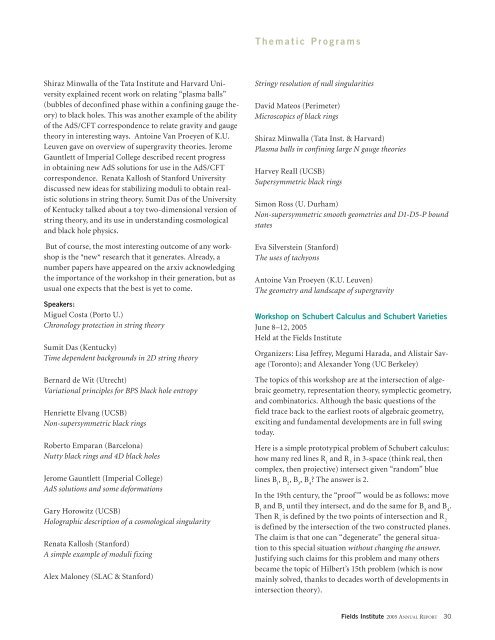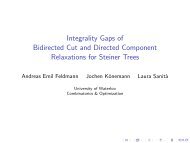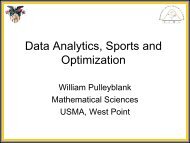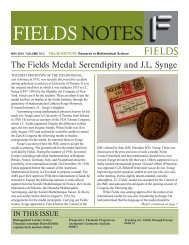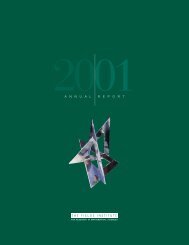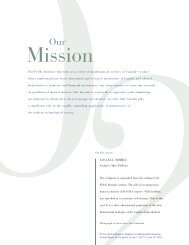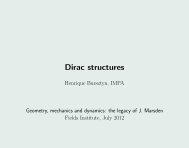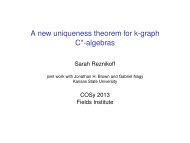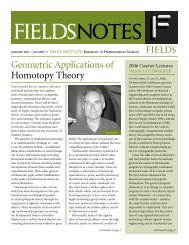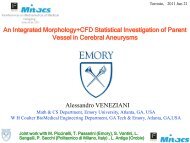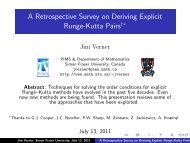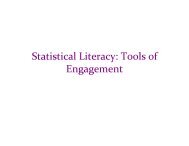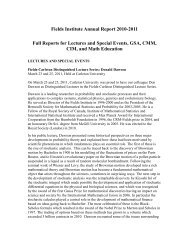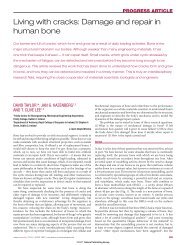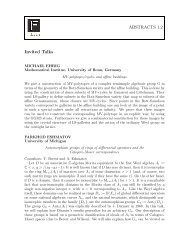Annual Report 2005 - Fields Institute - University of Toronto
Annual Report 2005 - Fields Institute - University of Toronto
Annual Report 2005 - Fields Institute - University of Toronto
You also want an ePaper? Increase the reach of your titles
YUMPU automatically turns print PDFs into web optimized ePapers that Google loves.
Shiraz Minwalla <strong>of</strong> the Tata <strong>Institute</strong> and Harvard <strong>University</strong><br />
explained recent work on relating “plasma balls”<br />
(bubbles <strong>of</strong> deconfined phase within a confining gauge theory)<br />
to black holes. This was another example <strong>of</strong> the ability<br />
<strong>of</strong> the AdS/CFT correspondence to relate gravity and gauge<br />
theory in interesting ways. Antoine Van Proeyen <strong>of</strong> K.U.<br />
Leuven gave on overview <strong>of</strong> supergravity theories. Jerome<br />
Gauntlett <strong>of</strong> Imperial College described recent progress<br />
in obtaining new AdS solutions for use in the AdS/CFT<br />
correspondence. Renata Kallosh <strong>of</strong> Stanford <strong>University</strong><br />
discussed new ideas for stabilizing moduli to obtain realistic<br />
solutions in string theory. Sumit Das <strong>of</strong> the <strong>University</strong><br />
<strong>of</strong> Kentucky talked about a toy two-dimensional version <strong>of</strong><br />
string theory, and its use in understanding cosmological<br />
and black hole physics.<br />
But <strong>of</strong> course, the most interesting outcome <strong>of</strong> any workshop<br />
is the *new* research that it generates. Already, a<br />
number papers have appeared on the arxiv acknowledging<br />
the importance <strong>of</strong> the workshop in their generation, but as<br />
usual one expects that the best is yet to come.<br />
Speakers:<br />
Miguel Costa (Porto U.)<br />
Chronology protection in string theory<br />
Sumit Das (Kentucky)<br />
Time dependent backgrounds in 2D string theory<br />
Bernard de Wit (Utrecht)<br />
Variational principles for BPS black hole entropy<br />
Henriette Elvang (UCSB)<br />
Non-supersymmetric black rings<br />
Roberto Emparan (Barcelona)<br />
Nutty black rings and 4D black holes<br />
Jerome Gauntlett (Imperial College)<br />
AdS solutions and some deformations<br />
Gary Horowitz (UCSB)<br />
Holographic description <strong>of</strong> a cosmological singularity<br />
Renata Kallosh (Stanford)<br />
A simple example <strong>of</strong> moduli fixing<br />
Alex Maloney (SLAC & Stanford)<br />
T h e m a t i c P r o g r a m s<br />
Stringy resolution <strong>of</strong> null singularities<br />
David Mateos (Perimeter)<br />
Microscopics <strong>of</strong> black rings<br />
Shiraz Minwalla (Tata Inst. & Harvard)<br />
Plasma balls in confining large N gauge theories<br />
Harvey Reall (UCSB)<br />
Supersymmetric black rings<br />
Simon Ross (U. Durham)<br />
Non-supersymmetric smooth geometries and D1-D5-P bound<br />
states<br />
Eva Silverstein (Stanford)<br />
The uses <strong>of</strong> tachyons<br />
Antoine Van Proeyen (K.U. Leuven)<br />
The geometry and landscape <strong>of</strong> supergravity<br />
Workshop on Schubert Calculus and Schubert Varieties<br />
June 8–12, <strong>2005</strong><br />
Held at the <strong>Fields</strong> <strong>Institute</strong><br />
Organizers: Lisa Jeffrey, Megumi Harada, and Alistair Savage<br />
(<strong>Toronto</strong>); and Alexander Yong (UC Berkeley)<br />
The topics <strong>of</strong> this workshop are at the intersection <strong>of</strong> algebraic<br />
geometry, representation theory, symplectic geometry,<br />
and combinatorics. Although the basic questions <strong>of</strong> the<br />
field trace back to the earliest roots <strong>of</strong> algebraic geometry,<br />
exciting and fundamental developments are in full swing<br />
today.<br />
Here is a simple prototypical problem <strong>of</strong> Schubert calculus:<br />
how many red lines R 1 and R 2 in 3-space (think real, then<br />
complex, then projective) intersect given “random” blue<br />
lines B 1 , B 2 , B 3 , B 4 ? The answer is 2.<br />
In the 19th century, the “pro<strong>of</strong>’” would be as follows: move<br />
B 1 and B 2 until they intersect, and do the same for B 3 and B 4 .<br />
Then R 1 is defined by the two points <strong>of</strong> intersection and R 2<br />
is defined by the intersection <strong>of</strong> the two constructed planes.<br />
The claim is that one can “degenerate” the general situation<br />
to this special situation without changing the answer.<br />
Justifying such claims for this problem and many others<br />
became the topic <strong>of</strong> Hilbert’s 15th problem (which is now<br />
mainly solved, thanks to decades worth <strong>of</strong> developments in<br />
intersection theory).<br />
<strong>Fields</strong> <strong>Institute</strong> <strong>2005</strong> ANNUAL REPORT 30


